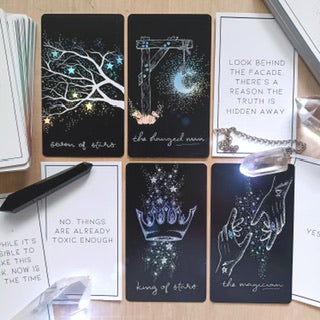exploring diverse perspectives in tarot card readings:
embracing the wisdom of tarot cards & their incredvaried meanings
you shuffle the cards, you lay them out, you turn them over. then what? do you instantly take stock the cards present, ensuring that the death card, the devil, the tower, and the nine of swords aren’t there to ruin the party? what’s your style?
maybe you don’t even look at which cards are present. instead, you choose to enjoy the artwork and designs facing up at you. choosing to focus on how they make you feel intuitively. or maybe you have a system where you look at different elements of the cards, layering them together for an in-depth multi dimensional reading.
its no secret that developing your way of reading the cards is a person thing that takes time, patience, and practice. over time, you develop your own ways of grouping and categorising the cards, seeing them through your own lenses.
for example, my dearest friend and tarot booklet co-writer, Marion Kirk of Marion K Tarot sees the Magician card as the one about relationships instead of the much more traditional Lovers card. this is because of the alchemy that the Magician provides; creating something new from other things.
this is just one of the things that i find amazing about tarot. the cards can be interpreted in so, so many ways.
there are several approaches to interpret a tarot reading, this list provides just some of them.
- intuitive: a method to trust your inner guidance & feelings about the cards. simply put, how you think & feel about the cards will steer the direction of the reading.
due to this, it is most definitely not the time to second guess or doubt yourself. also, it can be a really excellent practice in having total trust in your intuition.
- elemental: connecting the cards to the elements of earth, water, air, & fire. this is an aspect that can be used alone, or used with other approaches to add some serious depth and layers to your reading.
- numerological: explore meanings based on card numbers. very similar to using the elements. it can be very helpful to keep numerology reference guide close by, or keep a numerology website/app opened & ready use on your phone/device.
- symbolic: delve into the imagery & symbols on each card. this practice can be highly personal as you can assign your own meaning to the symbols or you can choose to follow more traditional meanings & descriptions.
as a result, this method can become highly personal and very much attended to you and your own perspectives.
- positional: consider card placements in the spread. questions each position of the card & also their position in relation to one another. this is very much how lenormand cards are read & interpreted.
not surprisingly, most folks read from left to right, but this is a personal choice. they can be looking at by the cards either side, but also above, below, & diagonal.
- narrative: to weave a story connecting the cards together. this is similar to the ‘storybook’ approach which is discussed further down. the main difference is the connecting and linking of the cards.
while the storybook approach tends to go left to right (like reading a story) but the narrative approach doesn’t need adds to be in any strict order. the keyword here is ‘weave’. this pertains to moving in more of a non linear direction to get a result.
this can be a great resource for learning the art of linking the cards and not simply seeing each card as an isolated, disconnected island of its very own information, symbols, and messages.
linking the cards & being able to not only view them as a whole, but to feel them energetically as a group is a very real skill to develop. it is also a skill that’s important enough to people that it can be a factor in helping them choose one professional reader from another.
- comparative tones: analyse differences & similarities between cards. light & dark, positive & negative, community & isolation, shining sun & freezing snow, movement & stagnation. by looking at that things that set the cards apart, as well as what brings the cards together, is a really interesting way to approach your interpretation of the cards.
additionally, you also don’t need to view the differences and similarities like others world. use your own personal perceptions to discern what brings cards together & what keeps them apart.
- historical: this is regarding the study of traditional tarot meanings & the historical context of the cards. while it is not difficult to learn per se, the difficultly lies in applying the historical, traditional meanings of the cards to the lives of people now in the year 2023 and beyond.
without a doubt, the difficult comes about as the cards were created in 1909. in all honesty, that actually wasn’t so long ago. nevertheless, 114 years serves as enough time to ensure radical differences from how the world was, to how it is now. these changes especially apply in the realms of society, identity, relationships, technology, faith, religion, & gender roles.
- psychological: relate cards to emotions & subconscious. this is an approach where Jung’s theories & texts can greatly help. his views of the cards, from his standpoint as a man of science, adds very interesting & thought provoking layers to the cards & their messages.
- intuitive lightning strikes: notice immediate insights that come to you, the very first thought, vision, idea, etc, that comes to mind. it’s very much like when you see someone undergoing a Rorschach test and they say the first thing that comes to mind upon viewing the inkblots.
being provided with immediate answers can offer insights that have the potential to be very revealing & oftentimes surprising. by saying the first thing we think of, we don’t have time to formulate a lie or facade to hide behind.
- meditative: enter a meditative state to receive insights, it’s a similar state of mind that’s used for automatic writing or when wanting to receive clear messages from one’s spirit guides. there is much importance on the preparation for this tarot reading approach.
online many guided calm down videos/audios can be found. focusing on one’s breathing, releasing the stress of the day, being in a position for both optimal comfort & energy flow also matters. depending on one’s preferences, yoga nidra is an alternative to use.
- contextual: consider your life situation(s) and apply the cards messages to what’s currently going on in your life. this is a far more ‘reality’ based approach where ones very real circumstances are taken into account & applied to the cards, their meanings, & their messages.
importantly, this can be helpful for those who feel more sceptical or who aren’t living a life within the realm of spirituality &/or divination.
- archetypal: explore cards as representations of archetypes. refer to this blog post for a list of the most common archetypes found in tarot. archetypes vary greatly but really are a great way to describe humans at their most core truth.
furthermore, for those who use tarot cards for creative writing can gain excellent ideas for character development & drivers of plot lines.
- personal reflection: encourage yourself to find personal meanings, in other words make the reading (& cards) as personal as possible. certain symbols may hold meaning to you and your family, or you and your significant other.
for example, the pair of black and white sphinxes in The Chariot card may not mean duality, masculinity, and femininity to you. it might remind you of the beloved black and white dog you had as a child. therefore bringing up emotions and reflections of nostalgia, comfort, and love.
- pattern recognition: identify recurring themes & symbols in the cards & then apply those to your own situation. daily tarot journaling and journaling of readings can be really handy when wanting to go back find search for arising patterns, when they began, if there are cycles, etc.
- colour symbolism: interpret cards' colours & their meanings. best to have a chart with an outline of colour theory handy when doing this. in contrast, it can be done via your own feelings & thoughts regarding each colour. for example, colour theory suggests red is a colour of power. but for many (including myself) it is a colour of warning.
- visual magents: notice where your eyes are drawn on each card. best to keep a pen & paper close by as if there are more than five or so cards present, you may forget what you were drawn to first. noting the cues & them finding your own messages within them can be a really fun & really eye opening approach.
- the cards as a storybook: treat the cards as scenes that add up to a larger story. each card is like a page/chapter of a story. when put together, all cards make one larger story. this is also a great way to learn & practise how to link the cards and their meanings.
- energetic frequency: sense the energies each card radiates & the energy when combining them. this is especially helpful for cards like many of the major arcana and all of the court cards as they are usually feminine or masculine.
hence, using energy as your way of reading means things like gender, relationships, religion, etc, can all be kept to one side as you focus on the energy.
- ancestral connections: relate cards to historical events or figures in your life and in your family/ancestral line. in the same way, this is great if you’re wanting to either make contact or improve contact with guides of yours which may be ancestors.
- dream analysis method: interpret cards like dream symbols. probably a good idea to keep a book or app close by with dream interpretations ready to search and read up the meanings of.
whatever approach you choose, embrace it with an open heart & let your intuition guide you. the beauty of having tarot being part of your life is the joy and happiness, insights and perspectives it can provide. at the very end of the day, the point is to enjoy it! 🤗🤗🤗

